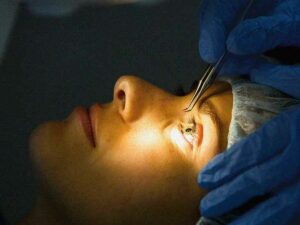Many people struggle with vision problems, which can impact their daily lives and activities. For many years, LASIK has been the go-to procedure for vision correction, but now there’s a newer, more advanced technique called Epi-Contoura. This innovative procedure uses advanced corneal topography technology to create a personalized treatment plan for each eye, resulting in improved visual outcomes. In this blog, we’ll explore what Epi-Contoura is, how it works, and its unique advantages over traditional LASIK surgery.
Contents
What Is Epi Contoura Surgery?
 Epi-Contoura Surgery is a type of corneal topography-guided laser vision correction procedure that uses advanced mapping technology to create a precise and personalized treatment plan for each eye. It combines the benefits of topography-guided ablation with the precision of wavefront-guided ablation. This procedure involves 5D eye tracking for additional safety and is suitable for patients with thin corneas.
Epi-Contoura Surgery is a type of corneal topography-guided laser vision correction procedure that uses advanced mapping technology to create a precise and personalized treatment plan for each eye. It combines the benefits of topography-guided ablation with the precision of wavefront-guided ablation. This procedure involves 5D eye tracking for additional safety and is suitable for patients with thin corneas.
What Technology Is Used In This?
Epi-Contoura uses corneal topography-guided technology to create a precise map of the cornea’s surface. This map is then used to guide the laser during the vision correction procedure. The technology used in Epi-Contoura is based on the excimer laser, which is a type of ultraviolet laser that can precisely remove tiny amounts of corneal tissue with sub-micron accuracy. The excimer laser is coupled with a sophisticated computer algorithm that uses the corneal topography data to guide the laser beam, ensuring that the laser precisely reshapes the cornea according to the patient’s unique needs. This technology allows for highly precise, personalized treatment that can result in improved visual outcomes and faster recovery times.
Procedure Of Epi Contoura
Here is a detailed step-by-step procedure for Epi-Contoura:
1. Consultation
The first step in the Epi-Contoura procedure is a comprehensive eye exam and consultation with an eye surgeon. During the consultation, the surgeon will assess your eye health, determine your eligibility for the procedure, and answer any questions you may have.
2. Corneal Topography Mapping
If you are a good candidate for Epi-Contoura, the next step is to create a detailed map of your cornea’s surface using corneal topography technology. This map will guide the laser during the procedure and ensure that the treatment is precisely tailored to your individual needs.
3. Anesthetic Eye Drops
Before the procedure, the surgeon will administer anesthetic eye drops to numb the surface of your eye and prevent any discomfort during the procedure.
4. Corneal Epithelial Removal
The surgeon will then use a specialized instrument called an epithelial separator to remove the outer layer of your cornea, called the epithelium. This step is painless and takes only a few minutes.
5. Laser Treatment
With the corneal epithelium removed, the surgeon will then use the excimer laser to reshape the cornea’s surface according to the personalized treatment plan created during the corneal topography mapping. The laser treatment typically takes only a few minutes, and you may feel a slight pressure sensation in your eye during this time.
6. Follow-Up Care
The surgeon will provide specific instructions on how to care for your eyes during the recovery period, including how to use eye drops, avoid certain activities, and when it is safe to resume normal activities.
Advantages Of Epi Contoura
 Here are some advantages of Epi-Contoura:
Here are some advantages of Epi-Contoura:
- Personalized Treatment: Epi-Contoura uses advanced corneal topography-guided technology to create a precise and personalized treatment plan for each eye. This means that the procedure is tailored to your unique needs, resulting in improved visual outcomes and reduced risk of complications.
- Improved Visual Outcomes: It can improve visual outcomes by reducing higher-order aberrations and improving contrast sensitivity. This can result in sharper, clearer vision, especially in low-light conditions.
- Reduced Risk of Complications: Contuora vision has a lower risk of complications compared to traditional LASIK surgery because it removes only the corneal epithelium and not the underlying stroma. This can result in faster recovery times, reduced risk of infection, and less discomfort during the healing process.
- Fast Recovery: This procedure typically has a faster recovery time than traditional LASIK because it preserves more of the cornea’s natural structure. Most patients can return to normal activities within a few days of the procedure.
- Safe and Effective: Epi-Contoura is considered a safe and effective alternative to traditional LASIK. It is appropriate for those who are not good candidates for LASIK due to thin corneas, high prescriptions, or other factors. It has been shown to have high patient satisfaction rates and excellent visual outcomes.
Disadvantages Of Epi Contoura
Here are some potential disadvantages of Epi-Contoura:
- Limited Availability: Epi-Contoura is a relatively new procedure and is not yet widely available in all locations. It may be more difficult to find a qualified surgeon who performs Epi-Contoura in some areas.
- Cost: It is more expensive than traditional LASIK due to the advanced technology and personalized treatment plan.
- Longer Procedure Time: This procedure can take longer to perform than traditional LASIK due to the additional step of removing the corneal epithelium.
It’s important to discuss the potential risks and benefits of Epi-Contoura with a qualified surgeon during a consultation to determine if it’s the right procedure for you.
Cost Of Epi-Contoura Surgery
 The cost of Epi-Contoura surgery can vary depending on several factors, including the surgeon’s experience and location, the technology used, and the extent of the correction needed. On average, Epi-Contoura can cost between 80,000 INR- 1 Lakh INR in India. However, the cost may be higher in certain regions or areas with a higher cost of living. It’s important to note that insurance may not cover the cost of Epi-Contoura, as it is considered an elective procedure. Patients should discuss the cost and payment options with their surgeon during the consultation process.
The cost of Epi-Contoura surgery can vary depending on several factors, including the surgeon’s experience and location, the technology used, and the extent of the correction needed. On average, Epi-Contoura can cost between 80,000 INR- 1 Lakh INR in India. However, the cost may be higher in certain regions or areas with a higher cost of living. It’s important to note that insurance may not cover the cost of Epi-Contoura, as it is considered an elective procedure. Patients should discuss the cost and payment options with their surgeon during the consultation process.
How Is Epi-Contoura Surgery Unique?
Unlike traditional LASIK surgery, which removes a portion of the cornea’s stroma, Epi-Contoura removes only the corneal epithelium. This preserves more of the cornea’s natural structure and tissue. Thus, resulting in faster recovery times, reduced risk of infection, and less discomfort during the healing process. It involves no pain, touch, cut, blade, or flap formation. This can help in corneal polishing, and aberration removal and result in supervision. The entire process is monitored with technologically advanced machines. Moreover, the recovery in this procedure is 3 weeks, unlike others that take at least 1 month.
Recovery Process In Epi-Contoura
 The recovery process after Epi-Contoura surgery may vary depending on individual factors such as age, prescription, and overall health. However, here is a general overview of what patients can expect during the recovery process:
The recovery process after Epi-Contoura surgery may vary depending on individual factors such as age, prescription, and overall health. However, here is a general overview of what patients can expect during the recovery process:
- The first few hours after the procedure: After the surgery, patients may experience some discomfort, tearing, and light sensitivity. It’s recommended to rest with your eyes closed and avoid rubbing or touching your eyes.
- The first few days after the procedure: Patients may experience blurry vision, sensitivity to light, and some discomfort during the first few days after surgery. It’s important to avoid any strenuous activities and to use prescribed eye drops as directed by the surgeon. This can prevent infection and promote healing.
- 1-2 weeks after the procedure: During the first week, patients should avoid swimming, hot tubs, and other activities that could expose the eyes to water or potential irritants. Patients may also be required to wear protective goggles or eye shields during sleep to prevent accidental rubbing or touching of the eyes.
- After 3 weeks: The patient may fully recover. This is the fastest recovery rate as compared to manual LASIK procedures.
Conclusion
In conclusion, Epi-Contoura is an advanced laser vision correction procedure that uses technology to reshape the cornea and improve visual outcomes. It offers several unique advantages such as faster recovery times, improved contrast sensitivity, and reduced risk of complications. If you’re considering Epi-Contoura or any other vision correction procedure, it’s important to speak with a qualified surgeon to determine the best course of action for your individual needs. Seek help from a qualified surgeon to learn more.
Lasik surgery is a safe 10-minute procedure to help you get rid of glasses. EyeMantra offers the most advanced LASIK options including PRK, Femto LASIK, SMILE surgery, Standard LASIK, ICL, and Contoura vision. If you have any questions on LASIK surgery in Delhi, Lasik surgery cost, and Lasik procedure, call us at 9711116605 or email at [email protected].


